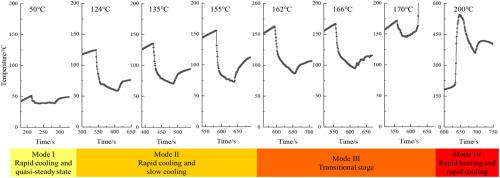Process Safety and Environmental Protection ( IF 6.9 ) Pub Date : 2021-10-24 , DOI: 10.1016/j.psep.2021.10.034 Jiajia Xu 1 , Qiangling Duan 1 , Lin Zhang 1 , Yujun Liu 1 , Chunpeng Zhao 1 , Qingsong Wang 1

|
The depletion of fossil fuels has led to the rapid development of environmentally friendly lithium ion battery (LIB). However, exposure of LIB to elevated temperatures frequently leads to battery failure, thermal runaway (TR), or even TR propagation. In this study, a series of experiments are conducted on the LIBs with and without water mist at different initial temperatures (50 °C and 106–206 °C) in a novel designed battery module to investigate the cooling effect of water mist. The results show that water mist reduces the possibility of battery failure and inhibits TR. The critical temperature of TR is enhanced by 36 °C. Moreover, using water mist to suppress the TR propagation requires reducing the temperature of a cell that undergoing TR to below 126 °C. Analysis of cooling rate indicates that there are four cooling modes ((Ⅰ) rapid cooling and quasi-steady state, (Ⅱ) rapid cooling and slow cooling, (Ⅲ) transitional stage, and (Ⅳ) rapid heating and rapid cooling) of water mist. The heat absorbed by water mist is distinct in four cooling modes. These results reveal that water mist has better cooling effect and the cooling mode changes with the increase of temperature, which may provide insight into the thermal safety performance of cells.
中文翻译:

不同初始温度下细水雾对18650锂离子电池冷却效果的实验研究
化石燃料的枯竭导致了环保型锂离子电池(LIB)的快速发展。然而,LIB 暴露在高温下经常会导致电池故障、热失控 (TR) 甚至 TR 传播。在这项研究中,在新设计的电池模块中,在不同初始温度(50°C 和 106-206°C)下对有和没有水雾的 LIB 进行了一系列实验,以研究水雾的冷却效果。结果表明,细水雾降低了电池失效的可能性并抑制了TR。TR 的临界温度提高了 36 °C。此外,使用水雾抑制 TR 传播需要将经历 TR 的细胞温度降低到 126 °C 以下。冷却速率分析表明,水有四种冷却方式((Ⅰ)快速冷却和准稳态,(Ⅱ)快速冷却和缓慢冷却,(Ⅲ)过渡阶段,(Ⅳ)快速加热和快速冷却)薄雾。水雾吸收的热量在四种冷却方式中是不同的。这些结果表明,细水雾具有更好的冷却效果,并且冷却方式随着温度的升高而变化,这可能有助于深入了解电池的热安全性能。











































 京公网安备 11010802027423号
京公网安备 11010802027423号